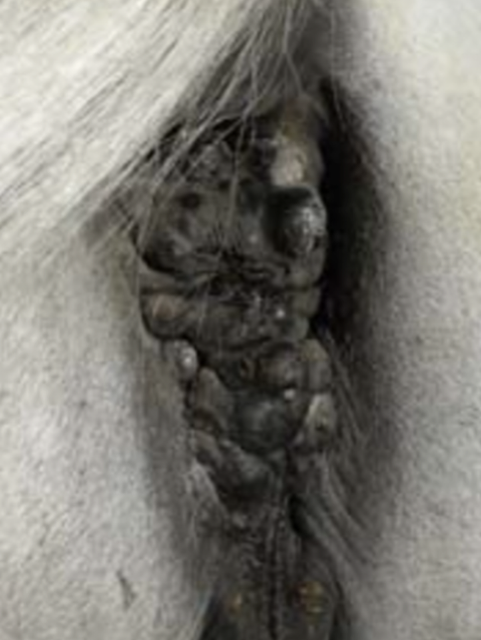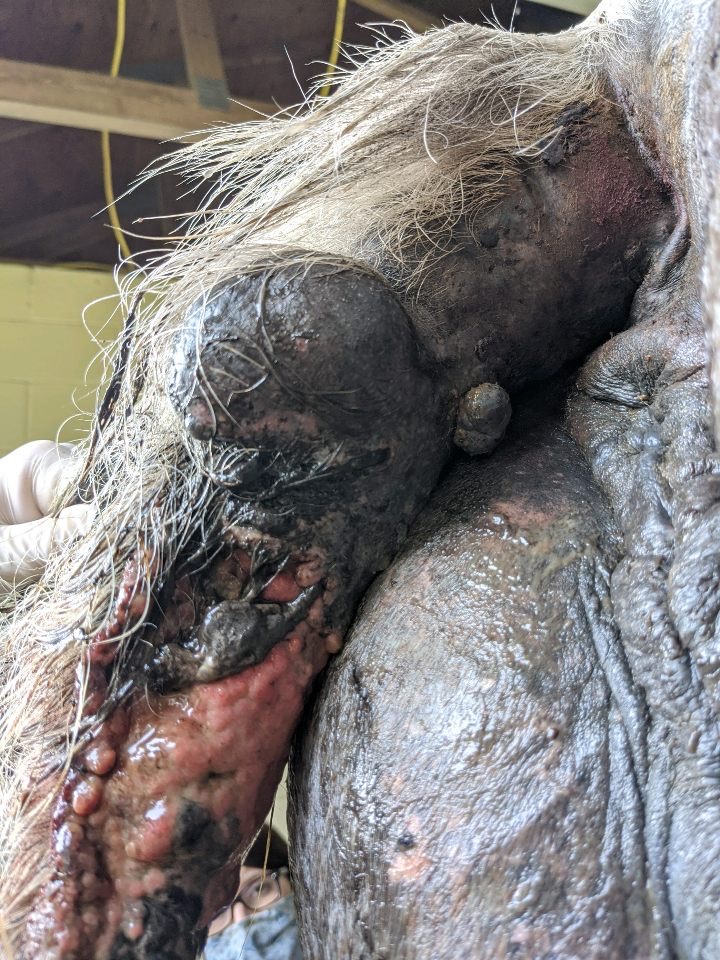Tuesdays with Tony
As horse owners I know you all know every curve, every scar and every lump or bump your horse has. So, when a new bump pops up it can be concerning. Any time I have a new scratch or lump or scab the humans are all over me, making sure I am okay. Frankly, it’s rather annoying. I am a perfectly healthy cat and don’t need them all over me all the time. I just need them to feed me and respond to all my demands. While I’m aware of my health, horses, they just aren’t as smart, and they need you to keep track of them. Monitoring new lumps and bumps can be lifesaving for your hose. This week I want to talk to you about a type of tumor that horses get that, for the most part, the docs will tell you not to worry too much about and just keep any eye on: Melanomas.
What is a Melanoma?
A melanoma is a type of skin tumor that occurs mainly in grey horses but can rarely occur in other colored horses as well. These tumors can pop up on your horse’s body just about anywhere. The most common areas include the underside and dock of the tail, corners of lips, neck, and head. They can also be found in and around your horse’s sheath, anus and from your horse’s iris in his eye.
Melanomas can pop up at any age in any horse with little known about any predisposing factors other than your horse’s color. That being said, most grey horses will not start to develop tumors until they’re around 10 years old. I am well into my teens, I am not grey, and thankfully, I am not a horse, so I think I am safe, but be sure to check on your grey horses.
As I mentioned, melanomas are part of owning grey horses. It’s usually advised to keep an eye on them for any significant changes. However, it is important to understand that “keeping an eye on them” does not mean allow them to grow uncontrollably. In fact, if your horse has been diagnosed with melanomas, you should have my docs check on them at least twice a year, measure them and possibly even take some photos of them. This will help ensure that the tumor does not progress rapidly and cause long term problems for your horse.
Treatment
While it is common practice to keep an eye on melanomas, there are other treatment options for them as well. One option is surgical removal. However, removal of one tumor will not prevent the development of other tumors. Likewise, if a tumor is too large or in a precarious location, surgical removal cannot be performed.
Injection with a chemotherapy agent is another treatment option. Cisplatin in the form of injectable oil or impregnated beads can be used around tumors to reduce the size of the tumor and allow for possible surgical excision. Treatment with cisplatin can be extremely effective, but it often takes several treatments and can get expensive.
Finally, there has been a vaccination developed for use in dogs that is still experimental in horses. The vaccine is created from your horse’s specific tumor, targets proteins in the melanoma cells, and stimulates an immune response. The vaccination shows promise for treatment of melanomas in horses, but more work is needed to prove its effectiveness.
Whatever form of treatment my docs recommend, it is important to start treatment early and not necessarily just keep an eye on it. Ask my docs which method is best and how to start treatment if your horse is diagnosed with melanomas.
Complications
If a melanoma is left to progress without intervention, they can become obstructive. Tumors around the head and neck can obstruct your horse’s airway and predispose your horse to choke. As you can imagine both of these conditions can be life threatening. If left to progress and grow, tumors around the anus can prevent your horse from passing manure.
Similarly, tumors in and around your horse’s sheath can lead to difficult urination. Remember our discussion about sheaths a few weeks back? Annual examination of your horse’s sheath will help the docs monitor your horse for tumor development, and if your horse in on one of our wellness plans, this examination is included. (Here is my shameless plug to sign your horse up for 2021 Wellness today.) If a tumor is allowed to progress and obstruct your horse’s sheath, urine scalding becomes a concern. When your horse cannot fully drop his penis from his sheath he’ll still have to urinate, and urine will splatter in all directions including on his abdomen and legs. This can lead to burning of these areas which is very painful.
Melanomas that arise from the iris of the eye can also become obstructive, leading to vision and other ocular problems. Any kind of tumor in the eye should be treated immediately. If left to progress, your horse may lose his vision completely, may develop uveitis (inflammation), glaucoma, or may lose his eye completely.
Besides obstruction, melanomas can become ulcerated, particularly underneath the tail. It is a warm, moist, dirty area and the perfect environment for these tumors to get really ugly and nasty really fast. Unlike cats, horses are disgusting creatures who fail to groom themselves regularly. Anyways, since your horse is lazy and allows you to groom and clean him, you must be the one to keep the underside of his tail clean. However, despite your most diligent efforts, melanomas are tumors and will do whatever they want, including becoming ulcerated, necrotic and/or infected. Once this happens, they can be nearly impossible to treat and can result in my docs having to recommend humane euthanasia for your horse.
The takeaway message is this: Have my docs monitor any lumps or bumps on your horse and show you exactly what kind of changes to watch for. Early, aggressive treatment is key and can be lifesaving for your horse.
Until next week,
~Tony
PS – Looking for more information on other conditions that may come up with your horse?My people also have a podcast that is filled with incredibly useful information, check it out here. Also, we will be having a VIRTUAL facebook seminar on Thursday October, 22 at 6:30. They will be talking about asthma/heaves. Wow, we have seen a lot, I mean a lot of heaves this year.
Tuesdays with Tony is the official blog of Tony the Clinic Cat at Springhill Equine Veterinary Clinic in Newberry, Florida. If you liked this blog, please subscribe below, and share it with your friends on social media! For more information, please call us at (352) 472-1620, visit our website at SpringhillEquine.com, or follow us on Facebook!
[jetpack_subscription_form title="Subscribe to Whinny's Wisdoms"]



